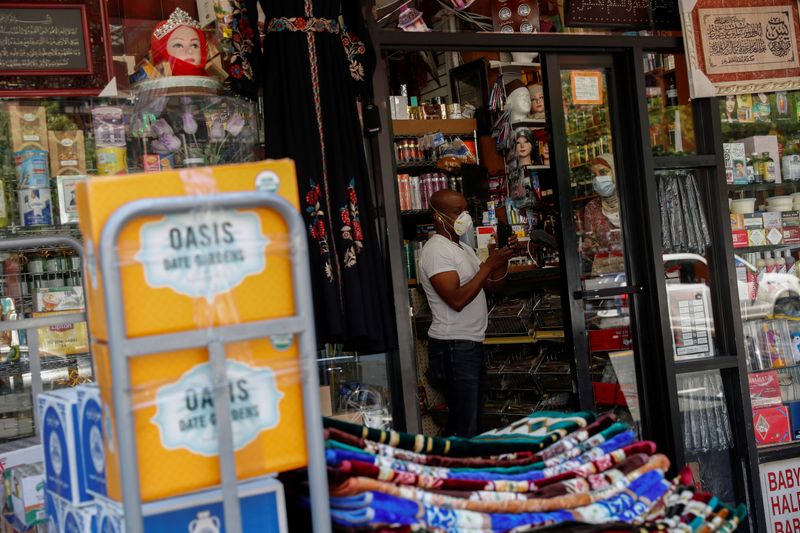By Lucia Mutikani
WASHINGTON (Reuters) - U.S. consumer prices fell for a third straight month in May and underlying inflation was weak as demand for goods and services remained subdued amid a recession caused by the COVID-19 pandemic.
But with nonessential businesses reopening after shuttering in mid-March to slow the spread of COVID-19, deflation, a decline in the general price level, is unlikely. Still, the report from the Labor Department on Wednesday suggested the disinflationary trend could persist for a while.
That together with a struggling labor market supports the Federal Reserve's commitment to maintain its very accommodative monetary policy stance for some time while nursing the economy back to health. The U.S. central bank said on Wednesday COVID-19 "will weigh heavily on economic activity, employment, and inflation in the near term."
"We expect the crisis to result in a sustained slowing in inflation due to a net increase in slack," said Jim O'Sullivan, chief U.S. macro strategist at TD Securities in New York.
The Labor Department said its consumer price index dipped 0.1% last month after plunging 0.8% in April, which was the largest decline since December 2008. Prices were held down by a 3.5% drop in the cost of gasoline, which followed a 20.6% plunge in April. That offset a 0.7% increase in the cost of food last month. Food prices jumped 1.5% in April.
Prices for food consumed at home rose 1.0% after surging 2.6% in April. The cost of beef shot up a record 10.8% in May, reflecting shortages as a result of COVID-19 infections at meat processing plants. Expensive food has led consumers to anticipate higher inflation this year.
Consumers also paid more for dairy products, fruits and vegetables. But cereals and bakery products were cheaper last month. In the 12 months through May, the CPI edged up 0.1%. That was the smallest year-on-year rise since September 2015 and followed a 0.3% increase in April.
Economists polled by Reuters had forecast the CPI would be unchanged in May and gain 0.2% year-on-year.
The National Bureau of Economic Research, the arbiter of U.S. recessions, declared on Monday that the economy slipped into recession in February.
The Labor Department said in-store data collection had remained suspended since March 16 because of risks of exposure to COVID-19. The department added that data collection last month was also impacted "by the temporary closing or limited operations of certain types of establishments," leading to "an increase in the number of prices being considered temporarily unavailable and imputed."
Stocks on Wall Street were mixed in choppy trading. The dollar fell against a basket of currencies. U.S. Treasury prices rose.
RENTS INCREASE
Excluding the volatile food and energy components, the CPI slipped 0.1% in May after decreasing 0.4% in April, the largest drop since the series started in 1957. The so-called core CPI fell in March for the first time since January 2010.
May marked the first time that the core CPI has dropped for three consecutive months. Underlying inflation was depressed by continued decreases in the costs of motor vehicle insurance and apparel. Airline fares fell 4.9% and used cars and trucks prices dropped 0.4%.
The cost of hotel and motel accommodation dropped 1.8% last month after record 8.1% plunge in April.
Those price declines offset a 0.3% increase in owners' equivalent rent of primary residence, which is what a homeowner would pay to rent or receive from renting a home. This rent measure gained 0.2% in April, likely reflecting forbearance agreements between landlords and tenants who have lost their jobs or have had their hours cut because of the global pandemic.
The economy has shed nearly 20 million jobs since March.
Healthcare costs increased 0.5% in May after a solid 0.4% rise in April. Consumers paid more for household furnishings, new vehicles, alcoholic beverages and education.
In the 12 months through May, the core CPI rose 1.2%, the smallest gain since March 2011. The core CPI increased 1.4% year-on-year in April.
The Fed tracks the core personal consumption expenditures (PCE) price index for its 2% inflation target. The core PCE price index increased 1.0% on a year-on-year basis in April, the smallest advance since December 2010. May's core PCE price index data will be released at the end of the month.
The Fed projected core inflation rising 1.0% this year and picking up to 1.5% in 2021. Back in December, it forecast inflation at 1.9% this year and 2% in 2021.

"The weakness in the economy should keep downward pressure on inflation over time and we expect softness in the core measures to be reported for upcoming months," said Daniel Silver, an economist at JPMorgan (NYSE:JPM) in New York. "But we think that we probably have moved past the largest sequential monthly declines in inflation that came shortly after the virus spread."
